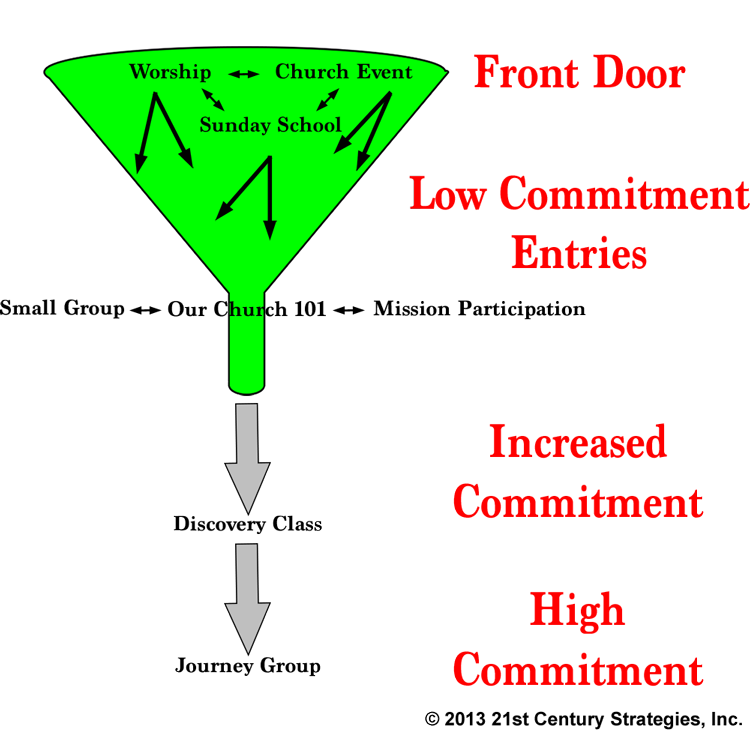Way back in the world of Christendom, discipleship was presumed to be a part of what the church did. Back then, most church members had been raised in the church and they would bring their children as a matter of course.
Today, however, the world has changed dramatically. Two generations now exist in the US that have been raised almost exclusively outside the church. When a member of this missing generation shows up in church, they are essentially clueless about what a “real” Christian is. By and large, they’ve learned about Christianity from the media and from the few people they’ve met and/or known who have claimed the faith – and that’s not always been a good thing. Disciple development, therefore, is critically important. We have misconceptions to correct, bad theology to redeem, and misbehaviors to supplant.
Only a few churches seem to have an intentional and established lay leadership development process. What this means is that a guest, a new Christian, or even someone new to the church must essentially fend for themselves in order to become an effective and faithful disciple. For instance, some churches have few small groups in operation and the groups that do exist were not created to develop effective disciples and/or leaders. The reason Sunday school is generally ineffective in developing disciples is because they are rarely relational, have limited weekly face time, and are more focused on accomplishing a task (completing the curriculum) than on developing disciples. The fact is, new Christians and new members (who were not raised in the church from childhood), do not know what it means to live the Christian life, and Sunday-only Christians are their primary examples, since often these are the only Christians they interact with. Further, when they do show up at church, they rarely have any idea about how to get connected into the church or how to explore being a more effective disciple.

Solve this mystery by developing a discipleship flowchart (see the example illustration) that provides a system and a clear path for helping people move from the front door through the steps that will take them into effective, faithful discipleship. This flowchart should track how a new member or regular participant moves from pre-Christian to mature disciple.
The Path to Discipleship
In the example shown, a visitor is introduced to the discipleship system through one of the church’s front door opportunities (worship, Sunday school, or a church event). Although a visitor may return based on excellent hospitality, few returning guests are willing to leap directly into a high commitment class or group. Thus, it’s important that a guest have the opportunity to test the discipleship waters by checking out a low-commitment entry such as a limited length small group (typically covering a relevant topic), an introduction class (“Our Church 101” in the example flowchart), or perhaps taking part in a church-sponsored mission project such as a servant evangelism project or serving in the local food bank alongside church members.
After a pilgrim (a guest who’s found their way into the process) has participated in a low-commitment entry event or two, it’s important that they grasp the “next steps” in discipleship. In the example, they would attend the Our Church 101 class (if they haven’t already) and from there would be invited to participate in a “discovery class.” Typically, a discovery class demands a limited-time commitment, but is probably longer than an entry-level small group. The curriculum for a typical discovery class includes a spiritual gifts inventory, an exploration of personal passions, a deeper exploration of ways to engage in personal mission and ministry, and a presentation of the gospel.
Once a pilgrim’s bio, contact, and gift information has been gathered, it should be entered into a database so that the participant’s leadership proclivities are available to all of the paid staff, as well as select unpaid staff.
The next step should, once again, be transparent to the guest (or new member by this time) and in time they should be guided into a high commitment, longer-term discipleship group (like the “journey group” in the illustration). A journey group would demand a long-term commitment that ushers disciples into increased spiritual maturity through teaching, training, and accountability. These groups tend to meet weekly nearly year round (with a suggested break during August to allow graceful exits of those who feel the need to move on and entrances for those looking to join a journey group.
For a variety of reasons, not everyone will make the commitment to a long-term discipleship group like a journey group. Therefore, it will be important to offer ongoing discipleship alternatives like one-on-one accountability, longer term small groups that meet in homes, etc.






Getting people plugged into a small group is really the most effective way to make sure that they are loved and cared for by the church.